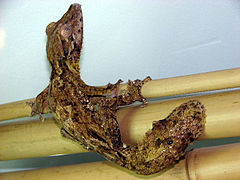Uroplatus
| Uroplatus | |||
| Duméril, 1806[1] | |||
 Przedstawiciel rodzaju – płaskogon Henkela (U. henkeli) | |||
| Systematyka | |||
| Domena | |||
|---|---|---|---|
| Królestwo | |||
| Typ | |||
| Podtyp | |||
| Gromada | |||
| Rząd | |||
| Infrarząd | |||
| Rodzina | |||
| Rodzaj |
Uroplatus | ||
| Typ nomenklatoryczny | |||
|
Stellio fimbriatus Schneider, 1797 | |||
| Synonimy | |||
|
| |||
| Gatunki | |||
| |||
Uroplatus – rodzaj jaszczurek z rodziny gekonowatych (Gekkonidae).
Zasięg występowania[edytuj | edytuj kod]
Rodzaj obejmuje gatunki występujące endemicznie na Madagaskarze i przybrzeżnych wyspach (Nosy Be, Nosy Komba, Nosy Mangabe i Nosy Boraha)[6].
Systematyka[edytuj | edytuj kod]
Rodzaj zdefiniował w 1806 roku francuski entomolog, ichtiolog i herpetolog André Marie Constant Duméril w publikacji własnego autorstwa poświęconej zoologii[1]. Gatunkiem typowym jest (oznaczenie monotypowe) płaskogon wielki (U. fimbriatus).
Etymologia[edytuj | edytuj kod]
- Uroplatus (Uroplates): gr. ουρα oura ‘ogon’[7]; πλατυς platus ‘szeroki’[8].
- Rhacoessa: gr. ῥακοεις rhakoeis ‘poszarpany, obdarty’[3]. Gatunek typowy (oznaczenie monotypowe): Stellio fimbriatus Schneider, 1797.
- Chiroperus: gr. χειρ kheir, χειρος kheiros ‘dłoń, ręka’[9]; πηρος pēros ‘okaleczony’[10]. Gatunek typowy: Chiroperus sarrube Wiegmann, 1834 (= Stellio fimbriatus Schneider, 1797).
- Lonchurus: gr. λογχη lonkhē ‘grot, lanca’[7]; ουρα oura ‘ogon’[11]. Gatunek typowy (oryginalne oznaczenie): Ptyodactylus lineatus Duméril & Bibron, 1836.
Podział systematyczny[edytuj | edytuj kod]
Do rodzaju należą następujące gatunki[6]:
- Uroplatus alluaudi Mocquard, 1894
- Uroplatus ebenaui (Boettger, 1879)
- Uroplatus fangorn Ratsoavina, Glaw, Raselimanana, Rakotoarison, Vieites, Hawlitschek, Vences & Scherz, 2020
- Uroplatus fetsy Ratsoavina, Scherz, Tolley, Raselimanana, Glaw & Vences, 2019
- Uroplatus fiera Ratsoavina, Ranjanaharisoa, Glaw, Raselimanana, Miralles & Vences, 2015
- Uroplatus fimbriatus Schneider, 1797 – płaskogon wielki[12]
- Uroplatus finaritra Ratsoavina, Raselimanana, Scherz, Rakotoarison, Razafindraibe, Glaw & Vences, 2019
- Uroplatus finiavana Ratsoavina, Louis Jr., Crottini, Randrianiaina, Glaw & Vences, 2011
- Uroplatus fivehy Ratsoavina, Glaw, Raselimanana, Rakotoarison, Vieites, Hawlitschek, Vences & Scherz, 2020
- Uroplatus fotsivava Ratsoavina, Gehring, Scherz, Vieites, Glaw & Vences, 2017
- Uroplatus garamaso Glaw, Köhler, Ratsoavina, Raselimanana, Crottini, Gehring, Böhme, Scherz & Vences, 2023
- Uroplatus giganteus Glaw, Kosuch, Henkel, Sound & Böhme, 2006
- Uroplatus guentheri Mocquard, 1908
- Uroplatus henkeli Böhme & Ibisch, 1990 – płaskogon Henkela[13]
- Uroplatus kelirambo Ratsoavina, Gehring, Scherz, Vieites, Glaw & Vences, 2017
- Uroplatus lineatus (Duméril & Bibron, 1836)
- Uroplatus malahelo Nussbaum & Raxworthy, 1994
- Uroplatus malama Nussbaum & Raxworthy, 1995
- Uroplatus phantasticus (Boulenger, 1888)
- Uroplatus pietschmanni Böhle & Schönecker, 2004
- Uroplatus sameiti Böhme & Ibisch, 1990
- Uroplatus sikorae Boettger, 1913
Uwagi[edytuj | edytuj kod]
- ↑ Wariant pisowni Uroplatus Duméril, 1806.
- ↑ Młodszy homonim Lonchurus Bloch, 1793 (Actinopterygii).
Przypisy[edytuj | edytuj kod]
- ↑ a b A.M.C. Duméril: Zoologie Analytique, ou Méthode Naturelle de Classification des Animaux, Rendue plus Facile à l’Aide de Tableaux Synoptiques. Paris: Allais, 1806, s. 80. (fr.).
- ↑ J.E. Gray. A synopsis of the genera of reptiles and amphibia, with a description of some new species. „Annals of Philosophy”. New Series. 10, s. 198, 1825. (ang.).
- ↑ a b J.G. Wagler: Natürliches System der Amphibien, mit vorangehender Classification der Säugethiere und Vögel. Ein Beitrag zur vergleichenden Zoologie. München, Stuttgart und Tübingen: In der J.G. Cotta’scchen Buchhandlung, 1830, s. 142. (niem.).
- ↑ A.F. Wiegmann: Herpetologia Mexicana, seu Descriptio amphibiorum Novae Hispaniae: quae itineribus comitis de Sack, Ferdinandi Deppe et Chr. Guil. Schiede in Museum Zoologicum Berolinense pervenerunt. Pars prima, Saurorum species amplectens, adiecto systematis saurorum prodromo, additisque multis in hunc amphibiorum ordinem observationibu. Berolini: C.G. Lüderit, 1934, s. 20. (łac.).
- ↑ L.J.F.J. Fitzinger: Systema reptilium. Fasciculus primus, Amblyglossae. Vindobonae: Braumüller et Seidel, 1843, s. 19, 97. (łac.).
- ↑ a b P. Uetz & J. Hallermann: Genus: Uroplatus. The Reptile Database. [dostęp 2024-01-05]. (ang.).
- ↑ a b Jaeger 1959 ↓, s. 276.
- ↑ Jaeger 1959 ↓, s. 200.
- ↑ Jaeger 1959 ↓, s. 54.
- ↑ Jaeger 1959 ↓, s. 188.
- ↑ Jaeger 1959 ↓, s. 143.
- ↑ E. Keller (red.), J.H. Reinchholf, G. Steinbach, G. Diesener, U. Gruber, K. Janke, B. Kremer, B. Markl, J. Markl, A. Shlüter, A. Sigl & R. Witt: Gady i płazy. Warszawa: Świat Książki, 2003, s. 99, seria: Leksykon Zwierząt. ISBN 83-7311-873-X. (pol.).
- ↑ Praca zbiorowa: Zwierzęta: encyklopedia ilustrowana. Warszawa: Wydawnictwo Naukowe PWN, 2005, s. 381. ISBN 83-01-14344-4.
Bibliografia[edytuj | edytuj kod]
- E.C. Jaeger: Source-book of biological names and terms. Wyd. 3 (Revised second printing). Springfield: Charles C. Thomas, 1959, s. 1–316. (ang.).
